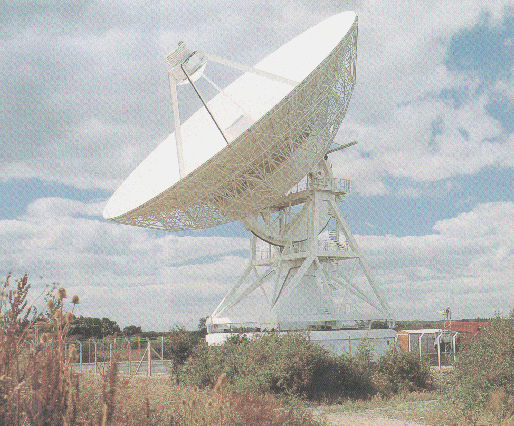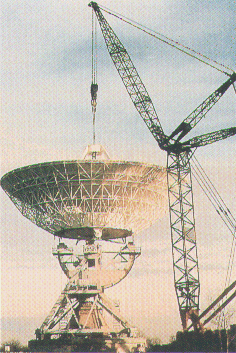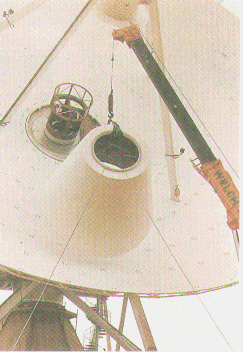

Since 1987 MERLIN has been operating with one of the 18-metre dishes of the One-Mile Telescope at the Mullard Radio Astronomy Observatory at the University of Cambridge. That extension greatly improve the resolving power of MERLIN and provided east-west baselines that the earlier network lacked.
But that arrangement was always intended to be temporary. From autumn 1990 the 18-metre has been replaced by a new, purpose-built telescope with a bowl 32 metres in diameter, constructed on a site leased from Cambride University and adjacent to the MRAO telescopes. Designed and built by the German company MAN GHH of Gustavsburg, near Munich, the 32-meter is the biggest single-dish telescope to have been constructed in the UK since the Lovell Telescope in 1957.
The main problem in any large reflector is to ensure that the surface maintains its parabolic shape at all elevations from the horizon to the zenith. The designers have achieved this by mounting the bowl on a strong, rigid steel ring at only four points. So long as the mounting points remain in a plane, gross distortion effects are nullified. An ingenious design principle known as homology ensure that even if the bowl sags further, it will remain a paraboloid and still produce sharp images.

The completed 32-metre telescope at Cambridge. (Keith Papworth).
With an average surface accuracy of 0.3 millimetres the telescope has already exceeded its specification, and Jodrell astronomers expect to align the surface panels even more precisely using their own holographic techniques. With such a smooth surface the telescope can work efficiently at wavelengths as short as six millimetres, where the atmosphere starts to become opaque to radio waves. Few telescopes in the world can compete at these wavelengths, and it is envisaged that the 32-metre will spend some of its time working independently of MERLIN as a powerful telescope in its own right.
Unlike the Lovell Telescope, whose receivers are mounted at a fixed "Prime Focus" above the bowl, the new telescope provides astronomers with a choice of focal points and receivers, any of which can be selected remotely from Jodrell Bank. As well as a prime focus, the 32-metre has a secondary "subreflector" which directs radiation back down into a focus laboratory built in the centre of the bowl. This allows engineers to work on the receivers in a controlled environment. The sub-reflector is controlled by an ingenious device which allows it to be adjusted in all possible motions to an accuracy of 0.1 millimetres. Receivers are mounted on a carousel and can be rotated automatically into the focus allowing observing frequencies to be changed be remote control.
An extremely accurate tracking system ensures that the telescope can follow objects in the sky to within a few seconds of arc.
The 32-metre telescope took two years to build and was completed on schedule and within budget.
 Lifting the bowl on to the new telescope, December 1989. |
 The focus laboratory being installed in the centre of the bowl. |